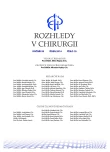Laparoscopic parastomal hernia repair with modified Sugarbaker technique in patients after abdominoperineal resection of the rectum – initial experience
Authors:
M. Škrovina 1,2; J. Bartoš 1; E. Holášková 1; M. Migrová 1; K. Klos 1; P. Anděl 1
Authors‘ workplace:
Chirurgické oddělení, Nemocnice Nový Jičín, a. s., Komplexní onkologické centrum Nový Jičín
primář: MUDr. M. Škrovina, Ph. D.
1; 1. chirurgická klinika, LF UP Olomouc, přednosta: prof. MUDr. Č. Neoral, CSc.
2
Published in:
Rozhl. Chir., 2014, roč. 93, č. 10, s. 502-506.
Category:
Original articles
Overview
Introduction:
Parastomal hernia is a common stoma complication. Surgical treatment is necessary in approximately 10 to 20% of cases. Mesh hernia repair gives significantly better results. The authors present their initial experience with laparoscopic repair of parastomal hernia using the modified Sugarbaker technique.
Material and methods:
In the period from January 2011 to December 2013, 15 patients with a symptomatic parastomal hernia underwent laparoscopic repair with modified Sugarbaker technique. All patients had a parastomal hernia at the site of terminal colostomy after abdominoperineal resection. 14 patients underwent primary hernia repair, 1 patient was operated on for recurrence of parastomal hernia after open hernia repair. Parietex™ Parastomal mesh was used for hernia repair in all cases.
Results:
Laparoscopic repair was performed successfully in all patients. The mean operating time was 45 minutes (range: 20−80 minutes). The mean postoperative hospital stay was 3 days (range: 2−6 days). No serious postoperative complication was recorded. In the postoperative period, a recurrent symptomatic hernia was found in 1 of 15 patients (6.7%) with reintervention 17 months after primary surgery.
Conclusion:
Laparoscopic hernia repair of parastomal hernia with modified Sugarbaker technique seems to be a safe method with a very low risk of postoperative complications, including hernia recurrence.
Key words:
terminal colostomy – parastomal hernia – laparoscopic repair – Sugarbaker technique
Sources
1. Carne PW, Robertson GM, Frizelle FA. Parastomal hernia. Br J Surg 2003;90 : 784−93.
2. Cingi A, Cakir T, Sever A, et al. Enterostomy site hernias: a clinical and computerized tomographic evaluation. Dis Colon Rectum 2006;49 : 1559−63.
3. Moisidis E, Curiskis JI, Brooke-Cowden GL. Improving the Reinforcement of Parastomal Tissues with Marlex Mesh. Dis Colon Rectum 2000;43 : 55−60.
4. Amin SN, Armitage JF, Abercrombie JH, et al. Lateral repair of parastomal hernia. Ann R Coll Surg Engl 2001;83 : 206−8.
5. Pekmezci S, Memisoglu K, Karahasanoglu T, et al. Laparoscopic giant parastomal hernia repair with prosthetic mesh. Tech Coloproctol 2002;6 : 187−190.
6. Guzman-Valdivia G, Guerrero TS. Laurrabaquio HV. Parastomal hernia repair using mesh and open technique. World J Surg 2008;32 : 465−470.
7. Janes A, Cengiz Y, Israelsson LA. Preventing parastomal hernia with a prosthetic mesh. Arch Surg 2004;139 : 1356−1358.
8. Gurita P, Popa R, Balalau B, et al. Parastomal hernia mesh repair, variant of surgical technique without stoma relocation. J Med Life 2012;5 : 157−61.
9. Cassar K, Munro A. Surgical treatment of incisional hernia. Br J Surg 2002;89 : 534−545.
10. LeBlanc KA. Incisional hernia repair: laparoscopic techniques. World J Surg 2005;29 : 1073−1079.
11. Sugarbaker PH. Peritoneal approach to prosthetic mesh repair of paraostomy hernias. Ann Surg 1985;201 : 344−6.
12. LeBlanc KA, Bellanger DE, Whitaker JM, et al. Laparoscopic parastomal hernia repair. Hernia 2005;9 : 140−144.
13. Voitk A. Simple technique for laparoscopic paracolostomy hernia repair. Dis Colon Rectum 2000;43 : 1451−1453.
14. Safadi B. Laparoscopic repair of parastomal hernias: early results. Surg Endosc 2004;18 : 676−680.
15. Berger D, Bientzle M. Laparoscopic repair of parastomal hernias: a single surgeon´s experience in 66 patients. Dis Colon rectum 2007;50 : 1668−73.
16. Hansson BME, Morales-Conde S, Mussack T, et al. Laparoscopic modified Sugarbaker technique is safe and has a low recurrence rate: a multicenter cohort study. Surg Endosc 2013;27 : 494−500.
17. Smietanski M, Szczepkowski M, Alexandre JA, et al. European Hernia Society classification of parastomal hernias. Hernia 2014;18 : 1−6.
18. Slater NJ, Hansson BME, Buyne OR, et al. Repair of parastomal hernias with biological grafts: a systematic review of the literature. J Gastrointest Surg 2011;15 : 1252−1258.
19. Hansson BME, Slater NJ, Schouten van der Velden AP, et al. Surgical techniques for parastomal hernia repair: a systematic review of the literature. Ann Surg 2012;255 : 685−95.
20. Hotouras A, Murphy J, Thaha M, et al. The persistent challenge of parastomal herniation: a review of the literature and future developments. Colorectal Dis 2013;15 : 202−214.
21. Janes A, Cengiz Y, Israelsson LA. Preventing parastomal hernia with a prosthetic mesh: a 5-year fallow-up of a randomized study. World J Surg 2009;33 : 118−121.
22. Wijeyekoon SP, Gurusamy K, El-Gendy K, et al. Prevention of parastomal herniation with biologic/composite prosthetic mesh: a systematic review and meta-analysis of randomized controlled trials. J Am Coll Surg 2010;211 : 637−645.
23. Brandsma HT, Hansson BME, van Haaren-de Haan, et al. Prevention of parastomal hernia with a prosthetic mesh in patients undergoing permanent end-colostomy; the PREVENT trial: study protocol for a multicenter randomized controlled trial. Trials 2012;13 : 226.
Labels
Surgery Orthopaedics Trauma surgeryArticle was published in
Perspectives in Surgery

2014 Issue 10
Most read in this issue
- Pilonidal sinus – possibilities surgical treatment
- Sinus pilonidalis – possibilities of surgical treatment
- Why are carotid glomus tumours dangerous?
- Laparoscopic parastomal hernia repair with modified Sugarbaker technique in patients after abdominoperineal resection of the rectum – initial experience
